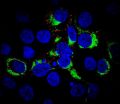(Press-News.org) DETROIT – A Henry Ford Hospital research team has identified specific genes that may lead to improved survival of glioblastoma, the most common and deadly form of cancerous brain tumor.
The molecular data is expected to aid further research into genes that either help or impede the survival of patients diagnosed with the tumor, which can invade and rapidly grow in any part of the human brain.
"Studies such as ours that help define molecular alterations associated with short-term survival likely will help define the reasons why our current treatments don't succeed in these patients," says Dr. Steven Kalkanis, M.D., a neurosurgeon and surgical oncologist at Henry Ford's Hermelin Brain Tumor Center, and lead author of the study.
"As new mechanisms of resistance are revealed and targeted agents are developed to address these mechanisms, the number of long-term survivors should increase."
The Henry Ford study was published this month in the journal Clinical Neurology and Neurosurgery.
The study focused on 476 patients at Henry Ford Hospital who were diagnosed with glioblastoma from 1995 to 2008. Each was randomly chosen from the Hermelin Center's brain tumor tissue bank, which holds more than 4,100 unique patient brain tumor specimens.
The patients were evaluated as part of the international Cancer Genome Atlas, to which the Hermelin Brain Tumor Center at Henry Ford Hospital was a major contributor.
Besides noting a steady rise in survival rates over the 14 years examined in the study, researchers found that the median survival time among this group rose from 11.8 months in patients diagnosed from 1995 to 1999 to 15.9 months in those diagnosed from 2005 to 2008.
After categorizing each patient as a short (less than nine months), medium (nine to 24 months) or long-term (at least 24 months) survivor, the researchers looked for relationships between survival time and patient age, gender, functional impairment, increases in tumor size, surgery and chemotherapy.
They then performed a molecular analysis of each tumor specimen and explored its relationship to short- and long-term survival.
Besides confirming earlier studies that showed improved survival of glioblastoma as new techniques and medications were introduced, the new study found:
Survival times among Henry Ford patients were ahead of national glioblastoma survival trends.
Those age 70 and older included more short-term survivors that the younger age groups.
Gender differences were only detected when comparing the short- and medium-term survivors, with females more likely to be short-term survivors.
The tumor's location within the brain was not a significant factor in survival time.
Specific genes identified by the researchers may independently improve patient survival. The Henry Ford team concluded that more and ongoing research in this area is vital to understanding how to fight the usually fatal cancer tumor.
"Among the factors which are associated with increased survival of glioblastoma patients during the time period we studied," says Tom Mikkelsen, M.D., a neuro-oncologist and co-director of the Henry Ford's Hermelin Brain Tumor Center, "is the multidisciplinary care coordinated by a dedicated tumor board as common practice for managing brain tumor patients. New expertise in neurosurgery, molecular pathology and experimental therapeutics are critical and must be personalized for each patient."
While the medical community is engaged in an ongoing debate about the usefulness of such boards, Dr. Kalkanis says his team's research found that not only are they "warranted," but "necessary" for the future treatment of glioblastoma and continuing to improve patient quality of life and survival rates.
INFORMATION:
Funding: Sources include HBTC philanthropy and the NIH (NHGRI/NCI) Cancer Genome Atlas.
Henry Ford researchers identify genetic factors that may aid survival from brain cancer
2014-05-12
ELSE PRESS RELEASES FROM THIS DATE:
Researchers find a new gene expression mechanism of PRRS virus
2014-05-12
MANHATTAN, Kan. — A collaborative study involving Kansas State University researchers has discovered a new gene expression mechanism in porcine reproductive and respiratory syndrome, or PRRS, virus — an important swine pathogen that costs the U.S. pork industry more than $600 million a year. The discovery provides a new avenue for scientists to explore strategies to control and prevent the disease.
Ying Fang, Ph.D., associate professor of diagnostic medicine and pathobiology at Kansas State University, led a study that looked at the unique gene expression mechanism of ...
Hospitals ranked on complications after hip and knee replacement surgeries
2014-05-12
With an aging population comes an increase in hip and knee joint replacement surgeries, totaling almost one million procedures per year in the United States. To provide better information on the outcomes of these surgeries, help inform patient choice, and improve the quality of the nation's hospitals, a team of Yale School of Medicine researchers have developed a measure for hospitals based on the complications following their patients' hip and knee replacements.
The team published an article in the May issue of the Journal of Bone and Joint Surgery showing there are ...
Dartmouth scientists identify genetic blueprint for cancerous tumors of the appendix
2014-05-12
Using next generation DNA sequencing, Dartmouth scientists have identified potentially actionable mutations in cancers of the appendix. Their study, "Molecular Profiling of Appendiceal Epithelial Tumors Using Massively Parallel Sequencing to Identify Somatic Mutations," was published in the journal Clinical Chemistry today. When specific mutations for a cancer type are identified, patients can be treated with chemotherapy or other targeted agents that work on those mutations.
Little is known about the molecular biology of two types of appendix tumors, low-grade appendiceal ...
Ames Lab creates multifunctional nanoparticles for cheaper, cleaner biofuel
2014-05-12
The U.S. Department of Energy's Ames Laboratory has created a faster, cleaner biofuel refining technology that not only combines processes, it uses widely available materials to reduce costs.
Ames Laboratory scientists have developed a nanoparticle that is able to perform two processing functions at once for the production of green diesel, an alternative fuel created from the hydrogenation of oils from renewable feedstocks like algae.
The method is a departure from the established process of producing biodiesel, which is accomplished by reacting fats and oils with alcohols.
"Conventionally, ...
Mount Sinai researchers identify changes that may occur in neural circuits due to addiction
2014-05-12
A research team from the Friedman Brain Institute of the Icahn School of Medicine at Mount Sinai has published evidence that shows that subtle changes of inhibitory signaling in the reward pathway can change how animals respond to drugs such as cocaine. This is the first study to demonstrate the critical links between the levels of the trafficking protein, the potassium channels' effect on neuronal activity and a mouse's response to cocaine. Results from the study are published in the peer-reviewed journal Neuron on May 7, 2014.
The authors investigated the role of ...
Corn dwarfed by temperature dip suitable for growing in mines, caves
2014-05-12
WEST LAFAYETTE, Ind. - Lowering temperatures for two hours each day reduces the height of corn without affecting its seed yield, a Purdue study shows, a technique that could be used to grow crops in controlled-environment facilities in caves and former mines.
Raising the crops in isolated and enclosed environments would help prevent genetically modified pollen and seed from escaping into the ecosystem and crossing with wild plants.
Cary Mitchell, professor of horticulture, said the technique could be particularly useful for growing transgenic crops to produce high-value ...
INFORMS study: Online buzz forecasts new product performance months before product release
2014-05-12
Companies can significantly improve the forecasting accuracy of forthcoming products' performance by mining online consumer buzz prior to product release, according to a study being published by Marketing Science, a journal of the Institute for Operations Research and the Management Sciences (INFORMS).
Social media attention to a firm's forthcoming products also influences its stock price, the study shows.
Pre-Release Buzz Evolution Patterns and New Product Performance is by Guiyang Xiong and Sundar Bharadwaj, professors at Terry College of Business at the University ...
Potential cure for captive amphibians with chytrid fungus
2014-05-12
Researchers at Vanderbilt University have identified an alternative to a sometimes toxic therapy that protects frogs in zoos from a deadly fungal infection that has been destroying the amphibian populations worldwide. Their research is published ahead of print in Applied and Environmental Microbiology.
The fungal disease, chytridiomycosis, has been decimating frogs all over the world. At present, nothing can help amphibians in the wild, but zoos currently rely on the often-toxic itraconazole to eradicate the disease from infected amphibians they wish to acquire.
To ...
UBC scientists find new way to mobilize immune system against viruses
2014-05-12
University of British Columbia scientists have uncovered an intricate chain reaction in the body's immune system and have used the knowledge to develop a new treatment against harmful viruses.
Viral pandemics, such as the coronavirus that caused the deadly SARS outbreak in 2002, have caused hundreds of deaths in Canada, yet effective anti-viral drugs are rare.
A key element to this natural immune response is an antiviral protein in the blood called Interferon alpha. Like soldiers, Interferon alpha is quickly deployed by the body to fight viruses and removed just as ...
Alcohol and drugs: Not just for modern man
2014-05-12
Unlike modern Man, the prehistoric people of Europe did not use mind-altering substances simply for their hedonistic pleasure. The use of alcohol and plant drugs – such as opium poppies and hallucinogenic mushrooms – was highly regulated and went hand-in-hand with the belief system and sacred burial rituals of many preindustrial societies. Elisa Guerra-Doce of the Universidad de Valladolid in Spain contends that their use was an integral part of prehistoric beliefs, and that these substances were believed to aid in communication with the spiritual world. Guerra-Doce's research ...


